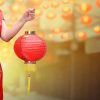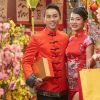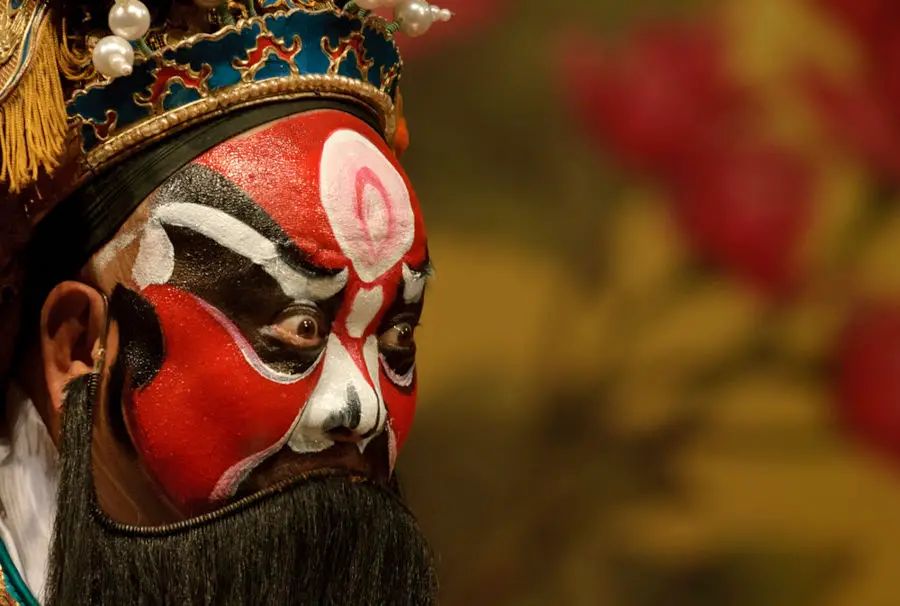
Although many in the West will be more familiar with operas by Italian or German composers, Chinese opera is an art with a long and fascinating tradition which is well worth learning more about. In this article, we explore the specificities of Chinese opera, its rich history and everything you need to know about the symbolism involved in this intriguing art form.
The History of Chinese Opera
The history of Chinese Opera is as complex as its tradition. To understand it is also to understand something of Chine art history and of the history of the country as a whole. Here, we have compiled an express history of this long-standing art form.
The beginnings of Chinese Opera go back hundreds of years, to the Qin Dynasty, who saw the first-ever Chinese Opera troupe touring the country. Although back then, the art was not nearly as evolved as it is today, there were already a couple of recognizable traditions. For example, from its beginnings, Chinese opera used tropes, archetypal characters that came back in every single production. Those included the man, the woman, the clown, and the mysterious painted face, or ‘hua’. Those characters, as well as the costumes that went with them, are still a staple of Chinese operas today.
It was Emperor Xuanzong who created the first official national cinema troupe, the ‘Pear Garden’ in the early 700s. This started a long history of friendship between Chinese leadership, and this beloved art form. Only during the Communist period did the relationship between State and Opera shift considerably.
It was over a millennium after the birth of the first Chinese opera that it became accessible to the masses. Indeed, only in the 13th century did the use of vernacular Mandarin become popularized as opera languages, taking over the more learned form of Classical Chinese.
This made Chinese Opera a truly ‘popular’ form, able to speak to people who may have been uneducated and to those who spoke other local languages. For example, Cantonese opera is one of the main branches of traditional Chinese Opera, with troupes performing in Cantonese rather than Mandarin.
Although the Communist era marked a dreadful shift for Chinese Opera, at its beginnings, the newly formed communist regime encouraged folk forms of Chinese opera. One can even argue that this art form was renewed and had some of its greatest successes during this historical era. As the political climate became a lot more hostile toward any artists accused of subversion however, Chinese Opera began to suffer.
The Cultural Revolution, which lasted from 1966 to 1976 left its blood mark on Chinese Opera. During that time, the communist regime in place attempted to destroy any remnants of Chinese tradition in the country, from dress and superstitions to arts and literature.
Hundreds of composers, scriptwriters and performers were purged during that era and performances of Chinese operas came to a halt. Only eight operas were allowed to be played during the whole of that decade, essentially stifling the creativity and inventiveness of Chinese opera performers all over the country.
When the bloodiest days of the Cultural Revolution were over, Chinese Opera slowly started picking up again. Old masters were once more able to transmit their trade to young artists and performances became legal once more.
In modern-day China, one cannot say that Chinese Opera is completely free. For example, many operas are still banned and many new ones are stopped from even seeing the light of day by government censorship. Rich from its age-old heritage, however, Chinese Opera remains a powerful force in the contemporary Chinese performance art world. Chinese opera lovers today are encouraged to admire the latest productions at the Peking opera of Beijing, the National Cantonese opera or the Huju opera of Shanghai.
Check out our “Free Culture Library“. We have compiled some great free resources, about Chinese culture, for your research.
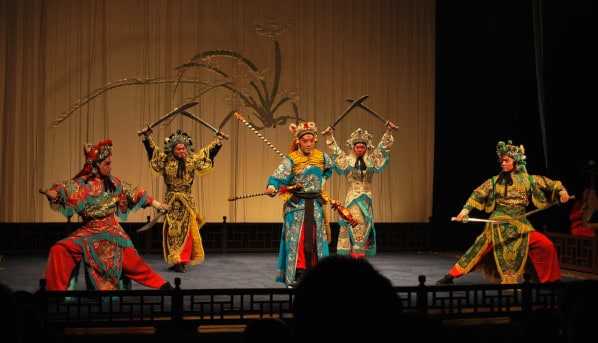
Chinese Opera Characters
As discussed earlier, the 4 main roles of Chinese Opera: male, female, painted face, and clown, have been an important part of this art form from the onset. The roles themselves, however, are just general categories and are further subdivided. Here is some context on the four major roles of Chinese Opera:
Sheng, or the male role.
Male characters in Chinese Opera generally belong to one of three categories: the young man, the old man, and the acrobatic figure.
- Young men can be romantic leads, children, or even the hero of the story. The actors who play them must possess an extraordinarily high-pitched voice, and this is a highly technical singing role.
- Old men, on the other hand, are often archetypal figures of the wise old man, the guide, or the villain.
- Finally, the acrobatic male role is usually a military role, given to a man capable of accomplishing feats of acrobatics while on stage. They will usually perform in stylized ritual combats, or be shown fighting against gods and demons. This is a technical role as much as the other ones, which requires particular strength and ability.
Dan, or the female role
The female characters of Chinese Opera come in a great number of variations. They may be virtuous (Qing Yi), seductive (Hua Dan), young mothers (Gui Men Dan), women generals (Dao Ma Dan), acrobats (Wu Dan) or older women (Lao Dan).
The abilities required by the actresses depend largely on the role that they are assigned. The Qing Yi role is all about grace and elegant dancing, the voice of the actress must be high and sincere.
The Hua Dan character is a much more comic and dramatic look, for which the actress must play at once a flirtatious woman, and be able to generate laughter from the audience. Her voice must be strong, although she won’t have to sing much. For the Wu Dan role of the acrobat, great strength and skill is required of the actress.
All six roles come with their own costumes, which makes it easy for spectators to understand the archetypes which they are facing in any Chinese Opera.
Online Courses about Chinese Culture from Udemy (Aff.link)
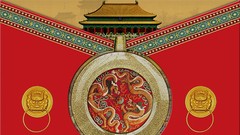
The Jing, or ‘Painted Face’ Role
There is no mistaking the Jing role for any other. The actor playing that part will be wearing bright, dramatic costumes, expressive facial makeup, and sometimes even a mask.
As to the role that they play, the Jin is generally a courageous and strong army general or warrior. The role has less emphasis on dancing and singing. Rather, the character is depicted as strong, able, and unsophisticated.
The Chou, or Clown Role
The Chou is the clown of the troupe. The purpose of this character is to generate laughter through amusing gestures and slapstick humor. As a general rule, the Clown role is attributed to a character who is dimwitted, and mischievous in his actions.
Clowns are neither good nor bad, they are the source of much of the comedy of Chinese Opera, and are neither particularly virtuous nor villainous.
Check out our “Free Culture Library“. We have compiled some great free resources, about Chinese culture, for your research.
Chinese Opera Costumes
Chinese Opera costumes are very diverse and creative but are also strictly codified.
- The first function of a costume in Chinese Opera is to convey the role or archetype of the character on the stage.
- The second function of the costume is to impress, as they are often beautifully designed and adorned pieces of clothing.
Here are a few of the costumes you may find on a Chinese Opera stage:
Watch out for characters in black hats and military uniforms, those are most often Lao Sheng, or young man.
Even easier to spot is the costume of the Hua Dan, the seductive woman. A Hua Dan is generally wearing very brightly colored clothes and is seen carrying a handkerchief in her hand. In fact, the handkerchief will play a big role in her seductiveness. Generally, she is associated with the colors red and pink, which symbolize passion and sexuality.
The female warrior or Dao Ma Dan has a characteristic costume comprising a Kao which is attached to her back and ornate but practical clothes. The costume of the Dao Ma Dan is all about impressing. It impresses because it conveys an impression of force on the one hand, but also because it is beautifully and richly adorned.
The easiest costume to spot in Chinese Opera is that of the Jing, which is heavy, dramatic, and impressive. The costume is generally padded on all sides to give the impression of a particularly robust character, while the heavy headdress adds to the height.
Chinese Opera costumes are an art form in and of themselves. The skill that goes into making them is as developed and ancient as the opera form. The best Chinese Operas know how to use costumes not only to signify the roles of each of the actors on the stage but also to add to the magic of the spectacle.

Chinese Opera Masks
Chinese Opera Masks are one of the main differences between Western opera and Chinese Opera. At first glance, Chinese Operas impress with their use of colors and imaginative costumes. The characters don’t only play a role, their whole outfit and appearance reveals and embodies the role which they are assigned.
Chinese Opera masks have a strong symbolic function, as they allow the spectator to see which character is to be trusted, which is the hero, which will be the villain etc. Furthermore, those masks serve an aesthetic function.
Chinese Opera is above all colorful, in its masks as well as costumes, decorations and the vividness of the actions that are staged. The colorful masks add to the drama of the play and make Chinese Opera the beautiful feat of multi-dimensional performance art that it is.
Click here to see some of our favorite Opera Masks.– Opens in new tab.
The History of Chinese Opera Masks
Long before colorful masks were used in Chinese Opera, they served a totemic function in Chinese society.
Even before the advanced of the opera, masks were used for their symbolic functions. In tales, stories, and paintings, masks were used to signify the character of a figure, whether it be malevolent, cunning, or courageous.
When Chine Opera developed, the troupes naturally turned to these age-old traditions and used well-known mask codes that spectators could readily understand because they were already present in the culture.
The Symbolism of Chinese Opera Masks Colors
Nothing is left to chance in Chinese Opera, and even the masks have a strong color symbolic associated with them. To understand the action, but also the relationships between characters in Chinese Opera, you need to be able to understand the meaning of mask colors.
One of the most common masks is makeup in the center of the face, in between the eyes and the nose. The character who wears that mask is simply ‘hua’, the clown. This character is present in most Chinese Operas and is an age-old archetype who provides comic relief throughout the play.
- Red is a very positive color in Chinese art and used on a mask it denotes bravery, fairness, and loyalty. In general, characters with mainly red masks can be trusted and are the heroes of the story.
- Black is equally positive, with connotations linked to decisiveness and impartiality.
- Pink masks are a sign of elegance, high standards, and gentlemanly behavior.
- Blue symbolizes courage but can also mean that the character has some psychic abilities. In a Chinese opera play, always trust the predictions of the blue-masked character!
- Green is not as positive, connoting erratic and unpredictable behavior.
- Yellow is a more devious color still, although it is not always negative. Characters who wear yellow masks are ambitious, sometimes to a fault.
- Finally, characters who wear white masks are mean, cruel and manipulative. You will be able to recognize them as anti-heroes straight away.
Click here to see some of our favorite Opera Masks.– Opens in new tab.
A Few Facts About Chinese Opera
- When we talk about ‘Chinese Opera’, what we are really talking about is the sum of over 360 different types of opera, including but not limited to Peking Opera and Cantonese Opera.
- Some types of Chinese Opera include circus techniques such as fire breathing and extreme acrobatics as part of their narrative.
- The Makeup and Costumes of Chinese Opera actors can take literal hours to put on. Preparation for the play far exceeds the length of the play itself.
- Costumes for Chinese Opera are so intricate and beautiful that they are kept over generations. It is not rare for an actor to wear the costume that his mentor wore before him.
- In China, it is not rare for men to play female characters in Chinese Operas. This is not considered unusual and is readily accepted by spectators as just a quirk of the play.
Stay in Touch
 Join our newsletter by using the forms on this website or click here!
Join our newsletter by using the forms on this website or click here! Follow us on Google News
Follow us on Google News Follow us on Facebook
Follow us on Facebook
Images:
- Feature Image from Depositphotos
- “Warriors” by -LJ- is licensed under CC BY-NC-ND 2.0
- “SHIFT” by Jimmy Yuan is licensed under CC BY-NC-ND 4.0


